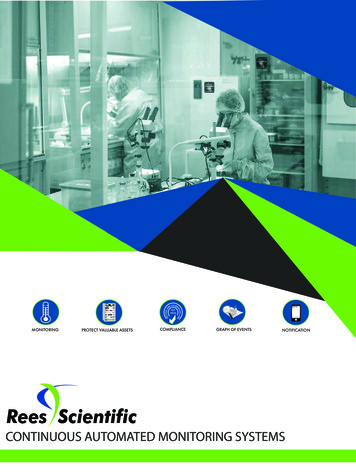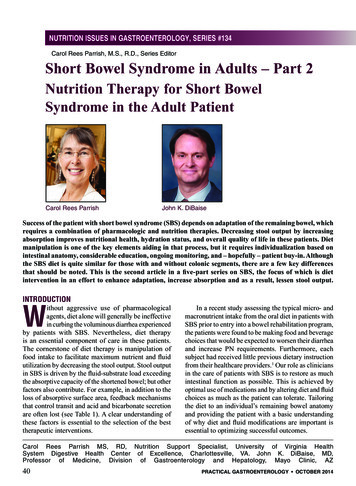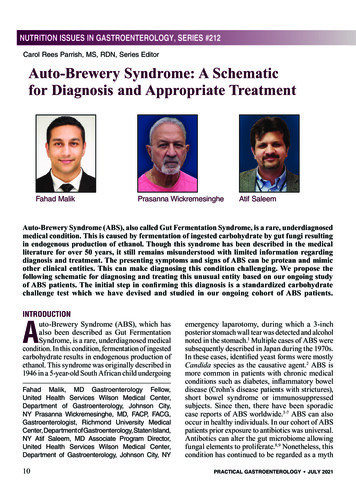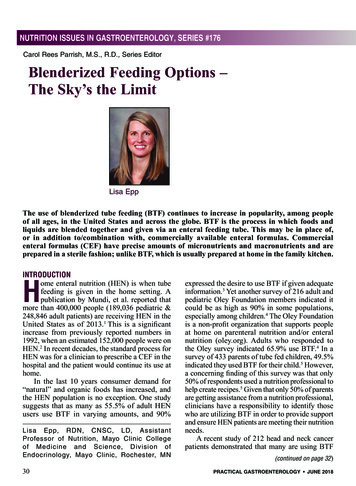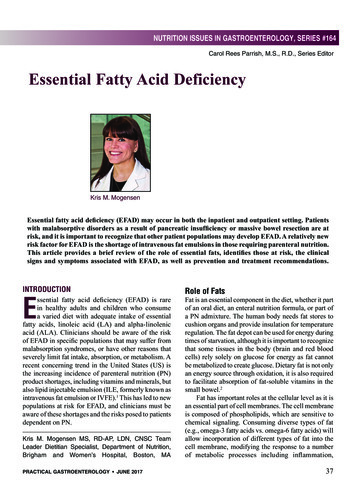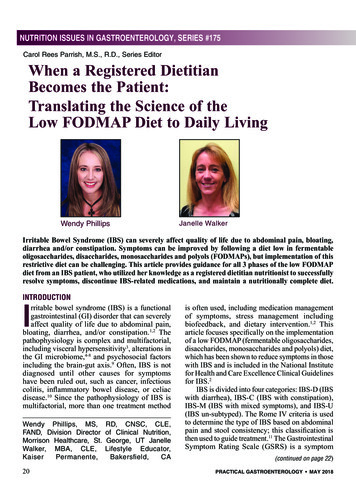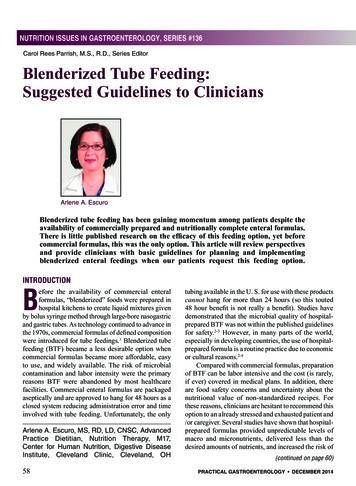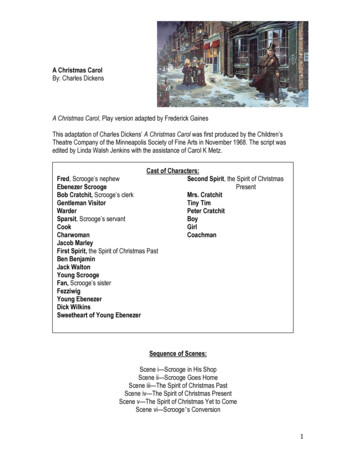
Transcription
NUTRITION ISSUES IN GASTROENTEROLOGY, SERIES #28Carol Rees Parrish, R.D., MS, Series EditorEnteral Formula Selection:A Review of SelectedProduct CategoriesAinsley MaloneThe availability of specialized enteral formulas has burgeoned in the last 20 years,many touting pharmacologic effects in addition to standard nutrient delivery. Enteralformulas have been developed for many specific conditions including: renal failure,gastrointestinal (GI) disease, hyperglycemia/diabetes, liver failure, acute and chronicpulmonary disease and immunocompromised states. Elemental and fiber supplemented formulas are also frequently recommended for use in those with certain typesof gastrointestinal dysfunction. This article will review the rationale for use of specialized formulas, provide the supportive evidence, if available, and provide suggestions forclinical application.INTRODUCTIONn the last 25 years the number and variety of enteralformulas that are available for use has increased dramatically. Well over 100 enteral formulas are nowavailable, making formula selection rather challenging.In addition, enteral formulas are considered food supplements by the Food and Drug Administration (FDA)and are therefore not under the same regulatory controlas medications. As a result, enteral formula labels maymake “structure and function” claims without priorIAinsley M. Malone, MS, RD, LD, CNSD, Mt. CarmelWest Hospital, Department of Pharmacy, Columbus,OH.44PRACTICAL GASTROENTEROLOGY JUNE 2005FDA review or approval. Furthermore, there is a lackof prospective, randomized, controlled clinical trialssupporting the purported indications for the majority ofthe specialized formulas currently on the market.Enteral formulas may be classified as standard,elemental or specialized. Many formulas are availablewithin each category, often containing significant differences in nutrient composition. Standard enteral formulas are defined as ones with intact protein containing balanced amounts of macronutrients and will oftenmeet a patient’s nutrient requirements at significantlyless cost than specialized formulas (See Table 1 for(continued on page 46)
Enteral Formula SelectionNUTRITION ISSUES IN GASTROENTEROLOGY, SERIES #28(continued from page 44)Table 1Cost Comparison of Commonly Used Standard FormulasEnteral FormulaCost/1000 Kcals ( )*Company1.0 cal/mLIsocalNutren 1.0Osmolite 1.07.205.225.73NovartisNestleRoss1.2 cal/mLFibersource 1.2Jevity 1.2Osmolite e1.5 cal/mLIsosource 1.5Jevity 1.5Nutren 1.54.406.373.72NovartisRossNestleCalorie Dense ProductsNutrient concentrations of standard formulas varyfrom 1.0–2.0 kcal/mL and products may or may notcontain fiber. These formulas may be used with volume sensitive patients or patients needing fluid restriction. Such conditions may include congestive heartfailure, renal failure or syndrome of inappropriatediuretic hormone (SIADH). However, this interventionmay not always be clinically significant (Table 3). Forexample, if a patient requires 1800 kcal/day, changinga 1.0 calorie/mL to a 2.0-calorie/mL product wouldreduce the water content by 900 mL, but to change apatient from a 1.5 to a 2.0 kcal/mL product representsa mere 300 mL difference per 24 hour period. Calorically dense formulas are most practical for use inpatients requiring nocturnal and/or bolus feeding.FIBER SUPPLEMENTED FORMULAS2.0 cal/mLDeliver 2.0Novasource 2.0Nutren 2.0TwoCal HN4.303.812.983.21NovartisNovartisNestleRoss*Based on 1-800 Company Home Delivery Numbers (see Table 17)commonly used products). Specialized formulas aredesigned for a variety of clinical conditions or diseasestates. There are over thirty-five specialized formulascurrently on the market. The purpose of this article isto review the rationale behind specialized formulas,provide supportive evidence, if available, and to furnish suggestions for clinical application. Enteral formulas for common food allergies as well as homemadeblenderized formulas are also discussed. Elementaland immune-modulated formulas will be reviewed infuture issues of Practical Gastroenterology.STANDARD FORMULASStandard formulas comprise the enteral product category most often used in patients requiring tube feedings. Their nutrient composition is meant to match thatrecommended for healthy individuals. Table 2 provides a comparison of nutrient sources in polymericand hydrolyzed products.46PRACTICAL GASTROENTEROLOGY JUNE 2005Proposed Rationale for UseDietary fiber is defined as a structural and storagepolysaccharide found in plants that are not digested inthe human gut (1). Sources of fiber in enteral formulasinclude soluble and insoluble (1). A recent fiber addition to selected formulas (Ross products) is fructooligosaccharides (FOS). FOS are defined as shortchain oligosaccharides and, similar to other dietaryfibers, are rapidly fermented by the colonic bacteria toshort-chain fatty acids (SCFA). SCFA influence gastrointestinal function through several mechanisms.They provide an energy source for colonocytes,increase intestinal mucosal growth and promote waterand sodium absorption (2). Table 4 provides a listingof enteral formulas and their fiber content.Fiber can be classified by its solubility in water.Soluble fibers, such as pectin and guar, are fermentedby colonic bacteria providing fuel for the colonocyte,as described above (1). In addition, increased colonicsodium and water absorption have been demonstratedwith soluble fiber, a potential benefit in the treatmentof diarrhea associated with EN (2). Insoluble fiber,such as soy polysaccharide, increases fecal weight,thereby increasing peristalsis and decreasing fecaltransit time (1).(continued on page 48)
Enteral Formula SelectionNUTRITION ISSUES IN GASTROENTEROLOGY, SERIES #28(continued from page 46)Table 2Macronutrient Sources in Enteral FormulasEnteral FormulaCarbohydrateProteinFatPolymericCorn syrup solidsHydrolyzed cornstarchMaltodextrinSucroseFructoseSugar alcoholsCaseinSodium, calcium, magnesium andpotassium caseinatesSoy protein isolateWhey protein concentrateLactalbuminMilk protein concentrateBorage oilCanola oilCorn oilFish oilHigh oleic sunflower oilMedium chain triglyceridesMenhaden oilMono- and diglyceridesPalm kernel oilSafflower oilSoybean oilSoy lecithinHydrolyzedCornstarchHydrolyzed cornstarchMaltodextrinFructoseHydrolyzed caseinHydrolyzed whey proteinCrystalline L-amino acidsHydrolyzed lactalbuminSoy protein isolateFatty acid estersFish oilMedium chain triglyceridesSafflower oilSardine oilSoybean oilSoy lecithinStructured lipidsTable 3Water Content of Various Enteral Formula DensitiesCaloric Density% WaterVolume /1800 kcal (mL)Water by density for 1800 Kcal (mL)1.0 kcal/mL1.2 kcal/mL1.5 kcal/mL2.0 ically, soluble fiber has been difficult to addto enteral formulas due to its viscous nature. Manyearly fiber supplemented enteral formulas, therefore,contained soy polysaccharide as their primary fibersource. Subsequent technological advances haveenabled the inclusion of soluble fiber sources to enteralformulas and many now contain a combination of bothsoluble and insoluble fibers.Supporting EvidenceResearch evaluating fiber-containing enteral formulasin the management of diarrhea has demonstrated incon48PRACTICAL GASTROENTEROLOGY JUNE 2005sistent results (3–4). This may be related more to thetype of fiber provided rather than the overall fiberintake. In a small crossover study, Frankenfield andBeyer compared insoluble fiber with a fiber free formula in nine head injured enterally fed patients andfound no significant difference in diarrhea incidence(5). Khalil, et al compared a fiber free formula with aformula providing insoluble fiber on diarrhea incidencein surgery patients (6). No significant differences instool frequency or stool consistency were demonstratedbetween groups. Conversely, Shankardass, et al compared long-term enterally fed patients receiving a for(continued on page 50)
Enteral Formula SelectionNUTRITION ISSUES IN GASTROENTEROLOGY, SERIES #28(continued from page 48)Table 4Fiber Content of Selected Enteral FormulasProductTotal DietaryFiber (g/L)%Insoluble Fiber%Soluble FiberCost /1000 Kcal ( )*ManufacturerCompleatFibersource StdFibersource HNIsosource 1.5Isosource VHNJevity 1.0Jevity 1.2Jevity 1.5Nutren 1.0 w/FiberNutriFocusNovasource PulmonaryPeptamen w/FOSProbalancePromote w/FiberProtain XLReplete w/FiberUltracalUltracal Plus is*Based on 1-800 Company Home Delivery Numbers (see Table 17); ** McKesson (800/446-6380)mula containing insoluble fiber with those on a fiberfree formula. Fecal weight and number of stools perday were not significantly different between the groupsbut the incidence of diarrhea was significantly greaterin the group receiving the fiber-free formula (7). Insoluble fiber has not been clearly shown to improve diarrhea, especially in the acutely ill patient (3). Solublefiber has been associated with more promising results.In an evaluation of septic, critically ill patients in amedical intensive care unit (ICU), Spapen, et al compared a soluble fiber with a fiber-free enteral formula.Frequency of diarrhea was significantly decreased inthose receiving the fiber-supplemented formula (8). Inaddition, a recent evaluation of patients in a medicalintensive care unit receiving a soluble-fiber containingformula (N 20), demonstrated a decrease in diarrhealepisodes with the fiber-supplemented formula compared to a fiber-free formula (9).Use in the Clinical SettingEnteral formulas supplemented with soluble fiber arecloser to a normal diet; however, evidence for their use50PRACTICAL GASTROENTEROLOGY JUNE 2005remains weak. Several cases of bowel obstructionassociated with the use of insoluble fiber-containingformulas have been reported in the surgical and burnpopulation (10,11). Until further evidence is available,a fiber-free enteral formula in patients who requiremotility suppressing medications and/or are at risk forbowel obstruction or ischemia may be prudent. In arecent review of enteral nutrition in the hypotensivepatient, McClave and Chang, 2004, recommend theuse of a fiber-free formula in critically ill patients athigh risk for bowel ischemia (12).DISEASE SPECIFIC FORMULASRenal DiseaseProposed Rationale For UseFormulas designed for patients with renal disease varyin protein, electrolyte, vitamin and mineral content(Table 5). Generally, renal formulas are lower in pro(continued on page 52)
Enteral Formula SelectionNUTRITION ISSUES IN GASTROENTEROLOGY, SERIES #28(continued from page 50)Table 5Enteral Products Designed for Renal DiseaseProductManufacturerKcals/mLProtein(gm)**K (mEq)**P (mg)**Mg (mg)**Cost/1000Kcals ( )**Renal FormulasMagnacal RenalNeproNovaSource andard Concentrated FormulasDeliver 2.0NovartisNovaSource 2.0NovartisNutren 2.0NestleTwo-Cal HNRoss*Per 1000 kcals; **Based on 1-800 Company Home Delivery Numbers (see Table 17)tein, calorically dense and have lower levels of potassium, magnesium and phosphorus when compared tostandard formulas.sium and phosphorus, patients on dialysis should continue to receive a standard, high-protein formula.Supporting EvidenceHepatic DiseaseThere are no clinical trials comparing the efficacy ofrenal formulas against standard products.Proposed Rationale for UseUse in the Clinical SettingFormula selection depends upon a patient’s degree ofrenal function, the presence or absence of renalreplacement therapy, and the patient’s overall nutrientrequirements. Patients undergoing renal replacementtherapy have significantly increased protein requirements that may not be met with the current renal formulas available. Persistent hyperkalemia, hypermanganesemia, hyperphosphatemia is often the drivingfactor that leads most clinicians to switch from a standard formula to a renal product. In patients undergoingrenal replacement therapy, especially continuous venovenous hemodialysis (CVVHD), renal formulas arenot always necessary. These patients typically do notrequire fluid restriction and have higher proteinrequirements of 1.5–2.0 gm/kg/day (13). In order tomeet the higher protein needs of this patient population, supplemental protein powder is often necessary.In the absence of elevated levels of potassium, magne52PRACTICAL GASTROENTEROLOGY JUNE 2005Hepatic formulas offer increased amounts of branchedchain amino acids (BCAA): valine, leucine, andisoleucine; and reduced amounts of aromatic aminoacids (AAA): phenylalanine, tyrosine and tryptophan,compared to standard products. These alterations havebeen purported to promote a reduced uptake of AAAat the blood brain barrier, reducing the synthesis offalse neurotransmitters and thereby ameliorating theneurological symptoms that occur with hepaticencephalopathy (HE) (14). Two enteral formulas withincreased BCAA are available. See Table 6 for formulacharacteristics.Supporting EvidenceEvidence supporting the use of hepatic formulas isvery limited. Several trials evaluating BCAA inpatients with chronic encephalopathy have been conducted in an attempt to determine whether BCAA canimprove neurological outcome or improve tolerance todietary protein (15–18). In a multi-center trial, Horst,
Enteral Formula SelectionNUTRITION ISSUES IN GASTROENTEROLOGY, SERIES #28Table 6Enteral Formulas Designed for Hepatic DiseaseProductManufacturerKcals/mL% CHOKcals% FatKcals% ProKcalsHepatic-Aid IIHormel 12.0Cost/1000 Kcal*Comments Increased levels of leucine,isoleucine and valine Minimal phenylalanine tryptophanand tyrosine content Contains negligible amounts ofvitamins and minerals Contains standard amountsof vitamins and minerals 50% BCAA and 50% AAA 66% of fat is MCT 41.56 35.55*Based on 1-800 Company Home Delivery Numbers (see Table 17)et al (16) compared a BCAA enriched versus a mixedprotein enteral supplement. The BCAA supplementedgroup achieved nitrogen balance equal to that of thecontrol group without precipitation of HE. Additionalstudies in which patients were randomized to receiveeither an oral diet enriched with BCAA or standardamino acids failed to demonstrate clinical benefit(17,18). In a recent publication, Marchesini and colleagues (15) compared the use of an oral BCAA supplement with either an isonitrogenous standard proteinor isocaloric carbohydrate supplement on mortality,disease deterioration and the need for hospital admission in ambulatory patients with advanced cirrhosis.BCAA supplementation resulted in a statistically significant (p 0.039) decrease in the primary occurrenceevents, death, and disease deterioration. The authorsconcluded that there are benefits to routinely supplementing BCAA in patients with advanced cirrhosis.However, the impact of this study is limited by severalfactors including a higher drop out rate in the treatmentgroup. When the results are considered on an “intention to treat” basis there is no significant difference inmortality between the groups. Also, encephalopathyscores were not significantly different between thegroups. The BCAA enriched group did have greaterimprovements in nutritional status, possibly contributing to the reduced hospital admissions in that group. Inpractice, attention to those factors that limit nutritionintake, providing an evening snack, and adequate med-ications to control encephalopathy may be adequate toallow similar improvements in nutrition status. Whilethis study suggests a possible benefit to routine BCAAsupplementation, routine use of BCAA in the hospitalized patient with HE is not recommended.Use in the Clinical SettingThe routine use of BCAA enriched enteral formulas inpatients with advanced liver disease and/or HE is notrecommended at this time. Standard enteral formulascan successfully be used with most patients at a muchlower cost. However, in those patients who are refractory to routine drug therapy for HE and are unable totolerate standard protein intakes without precipitationof HE, the use of BCAA enriched enteral formulasmay be worth a short trial.Diabetes/HyperglycemiaProposed Rationale For UseSeveral formulas have been developed for use inpatients with diabetes mellitus (DM) (Table 7). Theseformulas offer a lower amount of total carbohydrateand a higher amount of fat than standard formulas aswell as a variation in type of carbohydrate. Carbohydrate sources generally consist of oligosaccharides,fructose, cornstarch and fiber. In normal subjects, the(continued on page 56)PRACTICAL GASTROENTEROLOGY JUNE 200553
Enteral Formula SelectionNUTRITION ISSUES IN GASTROENTEROLOGY, SERIES #28(continued from page 53)Table 7Enteral Formulas Designed for Diabetes MellitusProductManufacturerKcals/mL% CHOKcals% PROKcals% FATKcalsFiber(g/1000 mL)Cost/1000Kcal ( )*Choice DMDiabetiSource ACGlucerna SelectGlytrolResource 206.22*Based on 1-800 Company Home Delivery Numbers (see Table 17); **Ross Products was unable to provide this informationuse of more complex carbohydrates, such as fructose,cornstarch and fiber has been shown to improveglycemic control as a result of delayed gastric emptying and reduced intestinal transit (19). Formulasdesigned for patients with DM are based on thispremise. Due to the inherent viscosity of soluble fiber,most enteral formulas for DM contain a combinationof soluble and insoluble fiber.Supporting EvidenceThere are few randomized, controlled trials evaluatingdiabetic formulas in hospitalized patients with DM. Ina series of two studies, Peters, et al demonstrated thatthe use of a diabetic formula results in a reducedhyperglycemia compared to standard enteral formulas(20,21). It should be noted that these studies were conducted in healthy volunteers using a study protocolthat attempted to mimic continuous tube feedingadministration. Results of these studies cannot be generalized to hospitalized patients. Craig, et al (22) compared a formula for DM against a standard product inpatients with Type 2 DM residing in a long-term carefacility. There were no significant differences inHbgA1C or fasting serum glucose levels at baseline,monthly or at the study completion. Of note, there wasa trend towards lower infections in the study group.Two recent studies have evaluated diabetic formulas in hospitalized patients. Mesejo, et al compared adiabetic formula with a standard formula in hyperglycemic critically ill patients (23). Mean plasma andcapillary glucose levels as well as units of insulininfused per day were significantly lower in the diabeticformula group. There were, however, no differences in56PRACTICAL GASTROENTEROLOGY JUNE 2005secondary end points: intensive care unit length of stay,ventilator days or mortality between the two groups. Inan evaluation of hospitalized type 2 diabetics, LeonSanz, et al compared the effect of a diabetic formulaversus a standard formula on glycemic control (24).Mean glucose levels, at each of the three weekly measurement intervals, did not significantly change in thosewho received the diabetic formula. Mean glucose levelsin those receiving the standard formula increased significantly between weeks one and two with no changeoccurring in week three. Mean insulin dose was not different between the two groups during the study period.The authors concluded the use of a diabetic formula isassociated with a neutral effect on glycemic control. Theclinical significance of the results from this study isunclear. The mean blood glucose levels in the diabeticformula group for all three weeks were 200 mg/dLranging from 215–229 mg/dL whereas in the standardgroup mean blood glucose levels ranged from 198–229mg/dL. These results confirm that glucose control isvariable in a hospital setting and that while the use of adiabetic formula can affect blood glucose levels, theeffect has yet to be shown to be clinically important.Furthermore, the important findings of Van den BergheG, et al of a 40% reduction in infectious complicationsin a surgical (primarily cardiac) ICU with attention totight glucose control via insulin drips, may make theseproducts even less alluring in the ICU population (25).Use in the Clinical SettingAlthough inviting, the routine use of a formula for DMis not currently supported by the evidence at this time(26). However, in some circumstances when blood
Enteral Formula SelectionNUTRITION ISSUES IN GASTROENTEROLOGY, SERIES #28Table 8Formulas Designed for Pulmonary DiseaseProductManufacturerKcals/mL% CHO Kcals% PRO Kcals% FAT KcalsCost/1000 Kcals ( )*COPD FormulasNovaSource 720.040.055.055.140.06.725.334.287.50ARDS FormulaOxepaRoss1.528.116.755.2***Based on 1-800 Company Home Delivery Numbers (see Table 17); **Ross Products was unable to provide this informationglucose control is borderline, and the addition ofinsulin may present the greater burden, use of a diabetic formula may offer an advantage.Pulmonary DiseaseSpecialized enteral formulas have been developed fortwo types of pulmonary disease: chronic obstructive pulmonary disease (COPD) and acute respiratory distresssyndrome (ARDS). While there are similarities withthese products, distinct differences do exist (Table 8).Chronic Obstructive Pulmonary Disease (COPD)Rationale for UseIn the 1980’s, reports began to appear describing adverseventilatory effects when large amounts of dextrose-basedparenteral nutrition solutions were provided to patientswith and without COPD. The high amounts of dextroseprovided in standard parenteral nutrition formulas weredeemed culpable. This concept was carried over into theenteral nutrition arena with the introduction of a modified macronutrient formula designed for the COPDpatient. Substituting a portion of carbohydrate calorieswith fat calories was thought to limit carbon dioxide production resulting in improved ventilatory status.Supporting EvidenceMultiple studies comparing the effects of macronutrient metabolism on respiratory function and status offerconflicting results. Some have involved ambulatoryCOPD patients, while others have evaluated hospitalized patients with and without COPD. Therefore, it isnot possible to extrapolate equivocal results to patientsin the hospital setting.In 1985, Angelillo, et al (27) studied the effect offat and carbohydrate content on carbon dioxide (CO2)production in ambulatory COPD patients with hypercapnia. They demonstrated both a reduced CO2 production and respiratory quotient in those who receiveda high fat formula. Al-Saady, et al in 1989 (28) compared the effects of a high fat enteral formula with astandard formula on ventilatory status in hospitalizedpatients. Carbon dioxide levels and ventilatory timewere significantly reduced in the high fat formulagroup. In a more recent study, Akrabawi, et al (29) in1996 evaluated pulmonary function and gas exchangein ambulatory COPD patients receiving a high fat formula. No significant differences in respiratory quotientwere demonstrated with the high fat formula. Of note,gastric emptying time was noted to be significantlylonger following the high fat meal, however, the clinical significance of this is unknown.Early reports citing increased work of breathingand respiratory failure with large glucose intake werefound to have provided excessive calories overall (1.7to 2.25 times the measured energy expenditure). In aclassic study by Talpers, et al (30), 20 mechanicallyventilated patients received either varying amounts ofcarbohydrate (40%, 60% and 75%) or total kcals (1.0,1.5 and 2.0 times the basal energy expenditure). TherePRACTICAL GASTROENTEROLOGY JUNE 200557
Enteral Formula SelectionNUTRITION ISSUES IN GASTROENTEROLOGY, SERIES #28was no significant difference in vC02 among the varying carbohydrate regimens; however vC02 significantly increased as the total kcal intake increased. Theauthors concluded that avoidance of overfeeding is ofgreater significance than carbohydrate intake in avoiding nutritionally related hypercapnia. This lends support for the argument that reducing total calorie intakeis more important than limiting carbohydrate caloriesin preventing adverse ventilatory effects.Use in Clinical SettingOverall results demonstrating whether “chronic” pulmonary enteral products offer a clinical advantage tothe hospitalized patient are inconclusive. In the patientwith chronic pulmonary disease and limited respiratoryreserves, it is critical to monitor PaCO2 levels in relationship to overfeeding. The provision of hypocaloricfeeding may be the best option in this type of patient.Editor’s note: If a patient has an elevated PaCO2 whileseverely hyperglycemic, then it is unlikely that enteralnutrition is driving the excess PaCO2. Enteral feedingmust not only get into our patients, but also into thecells to effect CO2 production.ARDSRationale for UseAcute respiratory distress syndrome (ARDS) is a clinical illness characterized by hypoxemia ultimatelyresulting in respiratory failure (31). The cascade ofevents that occurs in ARDS is thought to involve alveolar macrophages and their release of pro-inflammatory eicosanoids derived from the metabolism ofarachidonic acid. Several of these metabolites, thromboxane A2, leukotrienes and prostaglandin E2, havebeen implicated in the development of acute lunginjury (32). A specialized enteral formula (Table 8)offering a modified lipid component designed to modulate the inflammatory cascade is available for usewith ARDS. This formula contains borage and fishoils, sources of g-linolenic and eicosapentanoic acidsas well as increased amounts of antioxidants. Theincreased presence of these fatty acids, through metabolic alterations known to occur in ARDS, lead to anincreased production of prostaglandins of the 1 series58PRACTICAL GASTROENTEROLOGY JUNE 2005and leukotrienes of the 5 series, metabolites associatedwith an anti-inflammatory and vasodilatory state.Vasoconstriction, platelet aggregation, and neutrophilaccumulation are reduced when the eicosanoid balancefavors anti-inflammatory rather than proinflammatorymediators (33).Supporting EvidenceThe evidence supporting the use of a specializedenteral formula for ARDS may have some merit. Preclinical animal data demonstrating positive effects ofeicosapentanoic (EPA) and g-linolenic acids (GLA) onpro-inflammatory mediator production, gas exchange,and oxygen delivery work led to the completion of amulti-center trial (N 98) evaluating the use of anARDS formula in patients with evidence of eitherARDS or acute lung injury (ALI) (33). Patients receiving the specialized formula showed a significantimprovement in gas exchange, required significantlyfewer days of mechanical ventilatory support, and haddecreased ICU stays compared to the control group.The authors concluded that the use of a specializedenteral formula would be useful in the management ofthose with or at risk of developing ARDS. However,questions have been raised about the possibility thatthe high omega-6 fat content of the control formulamay have exacerbated ARDS symptoms.In a recent report Tehila, et al (34), demonstratedsimilar results to the multicenter study by Gadek (33).Fifty-two ventilated patients with ARDS and/or acutelung injury were randomized to receive either anARDS or control formula. Patients who received theARDS formula had a significantly shorter length ofventilator time as well as a reduced ICU length of staycompared to the control patients. There was no difference in either hospital length of stay or mortalitybetween the two groups. The study has received criticism in that the control group might have done worsedue to the increased omega-6 fat content of the controlformula vs the beneficial effect of the study formula.Use in the Clinical SettingAlthough promising, the evidence to date does notsupport the routine use of a specialized ARDS productat this time.(continued on page 60)
Enteral Formula SelectionNUTRITION ISSUES IN GASTROENTEROLOGY, SERIES #28(continued from page 58)ENTERAL FEEDING IN PATIENTSWITH ALLERGIESTable 9Resources for Food AllergyIt is important to be aware of the composition ofenteral feeding products for patients with suspected ordocumented food allergies. Approximately 20% of thepopulation in industrialized nations has been reportedto suffer from adverse reactions to food. Nuts, fruitsand milk are the most common triggers (35,36). Epidemiological data indicate that these reactions arecaused by different mechanisms, with only about athird of the reactions in children and 10 percent ofthose in adults due to actual food allergy. The majorityof adverse reactions to food are non-immunologic inorigin with lactose intolerance being the most commontype of adverse reaction worldwide. However, truefood allergies are thought to affect up to 6% to 8% ofchildren under the age of ten and between 1%–4% of Food Allergy and Anaphylaxis Networkhttp://www.foodallergy.org/ Food Allergy and Intolerances—National Institutes of Healthhttp://www.niaid.nih.gov/factsheets/food.htm Food ContentsU.S. Department of AgricultureFood and Nutrition Information x.html American College o
44 PRACTICAL GASTROENTEROLOGY JUNE 2005 INTRODUCTION In the last 25 years the number and variety of enteral formulas that are available for use has increased dra-matically. Well over 100 enteral formulas are no
